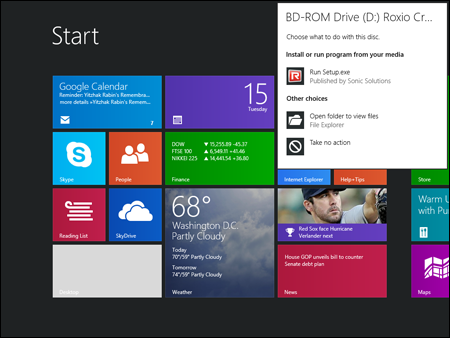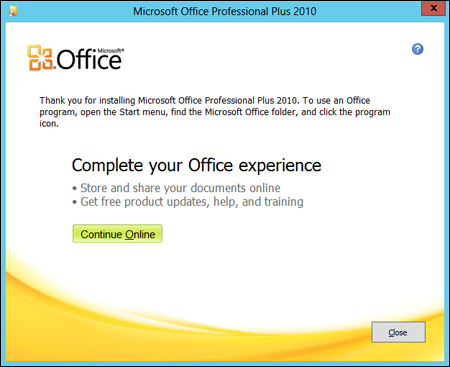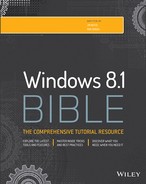Chapter 28: Installing and Upgrading Legacy Programs
IN THIS CHAPTER
Playing it safe with program installations
Updating versus upgrading
Installing programs from disks
Unlike documents, which you can freely copy to your hard disk and use on the spot, most new programs you acquire need to be installed before you can use them. The installation process configures the software to work with your particular hardware and software. The process also creates an icon or program group on the Windows 8.1 Start screen so that you can start the new program as you would any other.
You need to install a program only once, not each time you intend to use it. Once you've installed a program from a disk, you can put the disk away for safekeeping. You'll need the original installation disk to reinstall the program only if you accidentally delete it from your hard disk or if some sort of hard disk crash damages the program.
This chapter explores the common methods and issues you'll likely experience when installing programs for Windows 8.1. Keep in mind that the installation process, although similar across different programs, can still vary from one program to the next. So, the examples in this chapter are general, rather than specific.
Playing It Safe with Program Installations
Programs you buy in a store aren't likely to contain any malicious code such as viruses, worms, or spyware. Those things tend to be spread by e-mail attachments and free downloads from the web. However, there's always an outside chance that the new program is incompatible with Windows 8.1 or a hardware device on your computer. So, there may be times when you need to uninstall a program and then get all your system files back into shape to undo any changes made to your system by the new program.
![]() The Windows 8.1 System Protection greatly simplifies the task of getting things back in shape should a program installation or upgrade cause problems. But it helps only if it's turned on and you know how to use it. For details, see Chapter 24.
The Windows 8.1 System Protection greatly simplifies the task of getting things back in shape should a program installation or upgrade cause problems. But it helps only if it's turned on and you know how to use it. For details, see Chapter 24.
Updates Versus Upgrades
Non-technical people often assume that updates and upgrades are the same thing. They aren't. An update is usually something you do online. There is nothing to buy at a store, no disk to insert in a disk drive. Updates are generally free, and often automatic (many programs scan for updates and offer them to you automatically). You don't have to make an effort to seek those out and install them.
Updates for some programs may not be quite so automatic. But you can often find out if any updates are available right from the program's Help menu. For example, in Microsoft Office 2010 programs, select the File tab and choose Help. On the right pane, click Check for Updates to search the web for any Microsoft Office–related updates.
Unlike updates, upgrades are usually not free. You have to purchase them and install them. For example, let's say you have Microsoft Office 2010 installed on a computer. You want to get Office 2013 on that computer. In that case, you'd seek out an Office 2013 Upgrade Edition (which is cheaper than the regular edition). Then you'd install that upgrade right over your existing version. In other words, you wouldn't uninstall (remove) your existing version first.
Installing and Upgrading from a Disk
Before you get started here, you must have administrative privileges to install a program. In other words, you need to know the password for an administrative account on your computer. If you have a limited user account and don't know the administrative password, you'll need to get an administrator to install the program for you.
Most programs that you purchase will be delivered on a CD or DVD, or via an Internet download. You should always follow the installation instructions that come with such a program. But just so that you know what to expect, here's how the process usually works, once you have the installation files or CD/DVD in hand:
- Although not required, it's a good idea to run the installation with no other programs running to make sure you have plenty of system resources available and that no files that need to be updated by the installation are in use. Close all open program windows on your desktop by clicking their Close buttons or by right-clicking their taskbar buttons and choosing Close.
- For programs released on a disk, insert the CD or DVD into your computer's CD or DVD drive and wait a few seconds. Wait for the installation program to appear on your screen. If it doesn't appear within 30 seconds, see the section “Using the installed program” later in this chapter. Skip to Step 4.
- For programs released on a download from the Internet, find the installation or setup file, which will usually have an
.exefile extension. Double-click that file to launch it. - Follow the onscreen instructions to perform the installation.
That's really all there is to it. You'll be presented with some questions and options along the way. Exactly what you see varies from one program to the next, but some common items include the End User License Agreement (EULA), and the option to choose a folder in which to store the program, which we discuss in a moment.
For programs on a CD/DVD, sometimes your Windows setup may not launch the installation program automatically. If nothing happens within half a minute or so after you have inserted a program's installation CD/DVD into your computer's CD/DVD drive, you may need to start the installation program manually. Here's how:
- Open your Computer folder by clicking the File Explorer icon on the desktop taskbar and choosing Computer.
- Open the icon that represents the drive into which you placed the disk.
- If the installation program doesn't start automatically in a few seconds, click (or double-click) the icon named Setup or Setup.exe.
That should be enough to get the installation program started. From there you can follow the onscreen instructions to complete the installation.
The onscreen instructions and prompts you see during the installation vary from one program to the next. The next section discusses some common things you're likely to come across when installing just about any program.
Common Installation Prompts
Even though every program is unique in some ways, you're likely to come across some common elements during a program installation. When you install a program, you probably won't see all the prompts described in the sections that follow, so don't be alarmed if your installation procedure is much simpler. (Be thankful instead.)
The initial CD or DVD prompt
Shortly after you insert the installation disk for a program, you may see a prompt like the one in Figure 28.1. This is a new setup feature. Click this message to display the actions you can take with the installation disk. Figure 28.2 shows examples of setup options Windows 8.1 provides. In this case, you want to choose the Run ShelExec.Exe option. The most common option is Run SETUP.EXE, which is what you would click.
Figure 28.1
The first prompt after inserting an installation disk.

Figure 28.2
Windows 8.1 displays a message when it recognizes a disk with a setup program on it.

Entering an administrator password
Only people with administrative privileges can install programs in Windows 8.1. If you're signed into a limited account, you'll see a dialog box asking you to enter an administrative password. If you're already logged on with an administrative account, Windows 8.1 asks you if you want to allow the program to make changes to the computer. Click Yes to continue with Setup.
The product key or serial number
Many programs (including ones published by Microsoft, Adobe, Apple, and others) require that you enter a product key or serial number to install the program. That number is usually on a sticker on the case or sleeve in which the program was delivered.
If you do need to enter a product key or serial number, you'll see a prompt similar to the example shown in Figure 28.3. Type the product key exactly as it is provided by the software developer, and click Continue (or whatever button the installation program offers to continue the installation process).
Figure 28.3
Enter a product key.

Compliance check
If you're installing an upgrade of a new program and you already have the older version installed on your computer, the installation program likely will detect the existing product and move through the upgrade. In other situations, particularly where you don't already have a previous edition of the program installed, you might be prompted to insert the CD/DVD for the old version and/or enter the product key for the old version. This depends entirely on the requirements of the application's upgrade program. Follow the prompts displayed by the upgrade program to provide the requested information.
User information prompt
Some programs offer prompts that ask for your username or initials. These are optional but useful. The username will automatically be entered as the author name in any documents you create with the program. The initials will be used in settings where multiple people edit documents to identify changes you made to the document.
The End User License Agreement
Just about every commercial program and most freeware and open-source programs require that you accept the End User License Agreement (EULA) as part of the installation process. Figure 28.4 shows an example. The agreement is a legal document that defines your rights to the program, as well as the developer's retained rights.
Figure 28.4
A sample End User License Agreement.

The EULA differs from one program to the next. In most cases, the EULA gives you the right to install a program on one computer. However, that is not always the case. The EULA for Microsoft Office 2010 applications, for example, allows you to install the software on a licensed device (such as your desktop computer) and one portable device (such as your notebook PC). The intent of this clause is that you'll use the software on only one computer at a time. What's more, you can access and use the software on the device remotely from any other device. For example, this means you can connect to your office PC from home and run the Office application remotely on your office PC (or vice versa).
Although many people never read the EULA when installing a program, you should take the time to do so. You'll discover interesting bits of information (such as the fact that you can install Office on more than one computer) and also potential problems. For example, we've seen EULAs for shareware and commercial programs that explain that the Setup program will install other, third-party applications along with the program, and that by accepting the EULA you're indicating your acceptance of those other programs. These programs might have nothing to do with the program you're installing, such as weather monitors, Internet Explorer add-ons, toolbars, and so on. Often, the installation program gives you the option of not installing these additional programs, but that's not always the case. So, my best advice is to always read the EULA.
You can't install the program if you don't accept the terms of the agreement, so assuming you're happy with (or at least resigned to) the terms of the EULA, check the I Accept option and click Next, Continue, or whatever button continues the installation process.
Type of installation
Sometimes you'll be given some choices as to how and where you want to install the program. Figure 28.5 shows an example from Microsoft Office Professional 2010. Unless your computer is low on disk space, it's generally a good idea to install the program with all features. Otherwise, months later you may go to use some advanced feature of the program only to get an error message saying it's not installed. A nice compromise in Microsoft Office Setup is to choose the Installed On First Use option for a feature, which causes Setup to run when you try to use a feature that is not yet installed. Then you just pop in the CD or DVD, let Setup install the feature, and continue working.
Figure 28.5
Type of installation.

As to the where to install the program, there is rarely any reason to change the suggested location, which is typically some folder in C:Program Files. Don't change that unless you really have some good reason for doing it. Whatever you do, don't make the common newbie mistake of installing it in your Documents folder or someplace like that. You're not installing a document. You're installing a program. And it's best to keep all your programs in subfolders under C:Program Files.
Installation summary
The installation procedure might give you a summary of the options you chose along the way. Typically, you'll have a Back button or some other means to back up and make changes if needed.
Setup completed
The last page of the installation options might offer a couple of final options, as in the example shown in Figure 28.6. Whether you choose these options is relatively unimportant. You can check the web for updates and additional downloads at any time, whether through the program itself or by visiting the software company's website (or the Microsoft Update site).
Figure 28.6
Setup complete.

Some applications give you the option of keeping installation files on the computer rather than deleting them. Keeping the installation files can make it easier to change program settings or install missing components in the future. They usually don't take up any significant amount of disk space. Click Finish, remove the CD/DVD from the drive, and put it someplace safe in case you ever need to reinstall in the future.
You may also be prompted to shut down and restart Windows after the program is installed. If prompted, you can click Yes to restart now or click No to restart later. In any event, you must restart at least once before running the program for the first time.
Using the installed program
Once the program is installed, you can run it from the Windows 8.1 Start screen. The preceding steps installed Microsoft Office Professional 2010. So, to run it, you'd show the Windows 8.1 Start screen, scroll over to the application you want to start and click its tile.
Wrap-Up
Installing programs from files, CDs, or DVDs is easy to do. It's basically a matter of running the executable file, or putting the program installation disk into your CD or DVD drive and following the onscreen instructions. Here's a quick summary of the main points presented in this chapter:
- Consider creating a system restore point (see Chapter 31) before installing any program. That way, if the new program creates problems, use that restore point and return to the protection point to undo every change made during the program installation. Note that Windows 8.1 will create a restore point for you automatically in most situations.
- You need to install a program only once, not each time you want to use it. Once installed, you run the program from the new Windows 8.1 Start screen, without the program CD or DVD in the drive. In a few cases, the program requires the CD or DVD in the drive to validate that you have a licensed copy of the program (because possession of the CD or DVD implies that you haven't installed it by using someone else's media).
- If you're upgrading a program that's already installed, do not remove the existing version unless the installation instructions tell you to do so.
- The typical procedure for installing a new program is to insert the program's installation CD or DVD and follow the onscreen instructions. For a program that you download from the Internet, you simply need to double-click its setup filename.
- If nothing happens within a minute of inserting the installation disk, open your Computer folder, open the icon for the CD drive, and double-click the Setup or Setup.exe icon on the CD.
- When the installation is complete, store the installation disk in a safe place. In most cases you won't need it to run the program. But you may need it to reinstall the program should some mishap cause you to lose the program.
